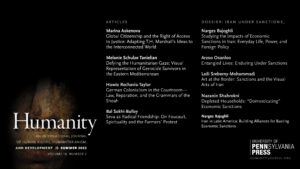Abstract: The essay analyses the role of human rights for the population control movement from the 1940s to the 1970s. It is based on records from the Population Council, the International Planned Parenthood Federation and the United Nations. It shows that rights-based language was introduced by advocates of population control and not by its critics and argues that portraying overpopulation as a problem for the realization of human rights became a successful political strategy in building alliances with states and the UN’s leadership. Both were key factors for the financial support and widespread implementation of population control programmes from the 1960s onwards.
Current Issue

Our long-awaited issue of Humanity journal is out! Its special dossier, Iran under Sanctions, examines the myriad and devastating impacts of international sanctions on society, culture, and politics. The issue includes an essay on the legal case Herero and Nama v. The Federal Republic of Germany to theorize reparations for German colonialism and slavery as they became linked with the aftermath of the Shoah. It also includes essays on T.H. Marshall and the right of access to justice; visual representations of Armenian genocide survivors; and, the concept of radical friendship in relation to the Farmers’ Protests in India.
View entire issue > Save Save Save
📘'Choose Your Bearing: Édouard Glissant, Human Rights and Decolonial Ethics' is now available for pre-order!
❕Grab your copy and save 30% OFF using the code NEW30 at checkout : https://edin.ac/3JIcRne
@HumanityJ